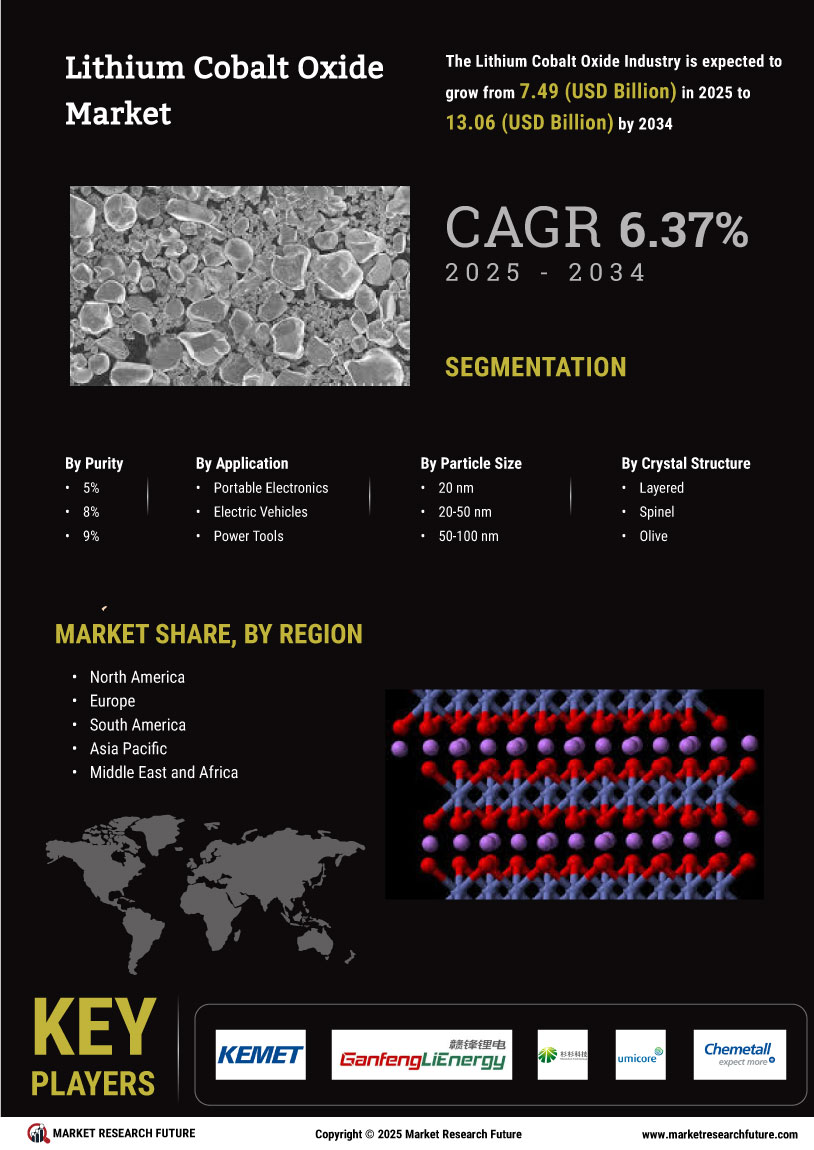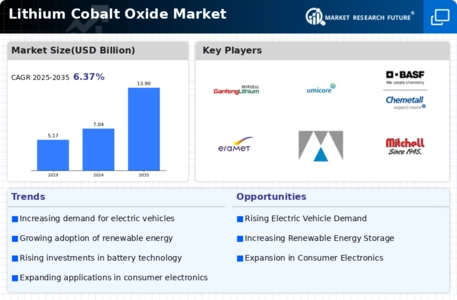Market Trends and Projections
The Global Lithium Cobalt Oxide Market Industry is poised for substantial growth, with projections indicating a market size of 7.04 USD Billion in 2024 and an anticipated increase to 13.9 USD Billion by 2035. This growth trajectory suggests a robust demand driven by various factors, including the rise of electric vehicles, advancements in battery technology, and increasing consumer electronics usage. The compound annual growth rate (CAGR) of 6.37% from 2025 to 2035 further underscores the market's potential. These trends highlight the critical role of lithium cobalt oxide in shaping the future of energy storage and transportation.
Growing Demand for Electric Vehicles
The increasing adoption of electric vehicles (EVs) is a primary driver for the Global Lithium Cobalt Oxide Market Industry. As governments worldwide implement stricter emissions regulations and provide incentives for EV purchases, the demand for lithium cobalt oxide, a key component in lithium-ion batteries, is expected to rise significantly. In 2024, the market is projected to reach 7.04 USD Billion, reflecting the growing reliance on this technology. By 2035, the market could expand to 13.9 USD Billion, indicating a robust growth trajectory. This trend underscores the importance of lithium cobalt oxide in supporting the transition to sustainable transportation.
Government Initiatives and Regulations
Government policies and regulations aimed at promoting clean energy and reducing carbon emissions are crucial for the Global Lithium Cobalt Oxide Market Industry. Many countries are implementing initiatives to encourage the use of electric vehicles and renewable energy sources, which in turn drives the demand for lithium-ion batteries. These regulations often include subsidies, tax incentives, and investment in charging infrastructure, creating a favorable environment for the growth of the lithium cobalt oxide market. As these initiatives gain momentum, the market is likely to see increased investments and innovations, further solidifying the role of lithium cobalt oxide in the energy transition.
Rising Demand for Consumer Electronics
The surge in consumer electronics, such as smartphones, laptops, and tablets, is a significant driver for the Global Lithium Cobalt Oxide Market Industry. Lithium cobalt oxide is widely used in the production of lithium-ion batteries that power these devices. As global consumer electronics sales continue to rise, the demand for lithium cobalt oxide is expected to follow suit. This trend is particularly evident in emerging markets, where increased disposable income is leading to higher electronics consumption. The interplay between consumer behavior and technological advancements suggests a sustained demand for lithium cobalt oxide in the foreseeable future.
Supply Chain Dynamics and Resource Availability
The dynamics of the supply chain and the availability of cobalt resources are pivotal factors influencing the Global Lithium Cobalt Oxide Market Industry. Cobalt, primarily sourced from the Democratic Republic of the Congo, faces challenges related to ethical sourcing and geopolitical risks. These factors can impact the stability of supply and pricing of lithium cobalt oxide. As manufacturers seek to secure their supply chains, there may be a shift towards alternative materials or recycling initiatives. This evolving landscape could affect market dynamics, prompting stakeholders to adapt to changing resource availability and sustainability considerations.
Technological Advancements in Battery Technology
Innovations in battery technology are propelling the Global Lithium Cobalt Oxide Market Industry forward. Advances in energy density, charging speed, and overall battery performance are enhancing the appeal of lithium-ion batteries, which utilize lithium cobalt oxide. These improvements not only increase the efficiency of electric vehicles but also expand their applications in consumer electronics and renewable energy storage. As manufacturers invest in research and development, the market is likely to experience a compound annual growth rate (CAGR) of 6.37% from 2025 to 2035. This growth reflects the ongoing evolution of battery technologies and their critical role in various sectors.







